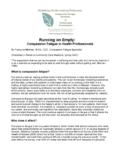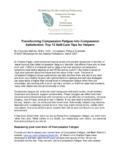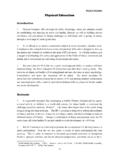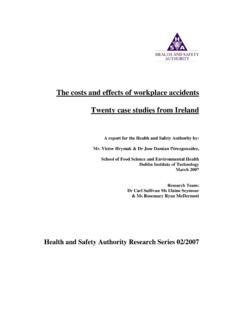Transcription of Burnout and Compassion Fatigue
1 HEALTH PROGRESS JULY - AUGUST 2011 47BY DENNIS PORTNOY, Catholic health care leaders, balancing mission with regulatory and fiscal realities means facing up to a future that demands delivering higher quality health care to more people at lower cost. In the struggle to provide quality, compassionate care in a climate that offers fewer resources and, at the same time, adapt to new business models, leaders can underestimate the strain on their front-line caregivers. But losing sight of Burnout and Compassion Fatigue which is a type of Burnout puts both the health care workers and their patients at risk. FIt takes a multi-pronged approach to minimize the negative impact. The organization and its policies play a key role by creating conditions that not only reduce the risk of Burnout and Compassion Fatigue , but also promote healthy, more effective involved in direct patient care are exposed to suffering and negativity on a daily basis.
2 They face increasing demands in the workplace, while at home they juggle family life, personal interests and often care for their own children and their aging par-ents as well. Psychologists Ayala Pines, , and Elliot Aronson, , describe Burnout as a state of physical, emo-tional and mental exhaustion caused by long-term involvement in emotion-ally demanding situations. It is accom-panied by disillusionment and nega-tive Psychologist and author Judith Herman writes that repeated exposure to people s suffering can diminish the helper s trust in humanity and often leads to a heightened sense of have described how Burnout among nurses affects the quality of treatment for patients, low-ers morale and increases absenteeism, with an accompanying financial impact on the hospital. Nurse turnover due to stress takes a financial toll, as , 4 Hospital leaders need to understand how downsizing, re-engineering and staff turnover causes Burnout in health care managers, as Anne M.
3 Nordhaus-Bike has In terms of dollars and cents, researchers Deborah Jones, Takeshi Tanigawa and Stephen Weiss place associated costs at $300 bil-lion annually. This figure includes estimates of the dollar effects of reductions in operat-ing effectiveness, medical expenses and attrition resulting from caregivers and their employers also need to learn to recog-nize signs of Burnout and Compassion Fatigue , because people in helping roles are at great risk. In the early stages, Burnout symp-toms include frequent colds, reduced sense of accomplishment, headaches, Fatigue , lowered resiliency and moodi-ness and increased interpersonal con-flicts. If not treated, Burnout gradually moves into an advanced stage display-ing symptoms of somatic complaints, social withdrawal, depersonalization, cynicism, exhaustion, irritability, low energy, feeling underappreciated and overworked.
4 In time, a helper becomes numb, disillusioned, hardened and overwhelmed. Often, caregivers don t realize the negative effects until they experience a health crisis or other sig-nificant Fatigue is a type of Burnout and Compassion Fatigue Watch for the SignsThe organization and its policies play a key role by creating conditions that not only reduce the risk of Burnout and Compassion Fatigue , but also promote healthy, more effective IT WORK AT WORKJULY - AUGUST 2011 HEALTH PROGRESS 46 JULY - AUGUST 2011 HEALTH PROGRESS 48burnout. It emerges suddenly and with little warn-ing, and it is usually more pervasive than burn-out. In addition to regular Burnout symptoms, a person experiencing Compassion Fatigue can feel a loss of meaning and hope and can have reac-tions associated with Post Traumatic Stress Dis-order (PTSD) such as strong feelings of anxiety, difficulty concentrating, being jumpy or easily startled, irritability, difficulty sleeping, excessive emotional numbing, intrusive images of another s traumatic material.
5 Past traumas can also be acti-vated. Long-term effects include reduced empa-thy, diminished sense of personal safety, reduced sense of control, hopelessness, increased involve-ment in escape activities and chronic overeating, drug or alcohol of the research on com-passion Fatigue has focused on counselors and first respond-ers who work with trauma vic-tims. Laurie Anne Pearlman and Lisa McCann, who have done research on the long-term effects of compas-sion Fatigue , report helpers develop a diminished sense of personal safety and disrupted schemas around trust, vulnerability, meaning and control. 7 There is overlap between Burnout and com-passion Fatigue , and an individual can suffer from both. They share some symptoms, and both take a toll on health and on relationships. Both affect the workplace in low morale, absenteeism, decreased motivation and apathy, though people suffering from Compassion Fatigue often love their jobs.
6 Compassion Fatigue is caused by empathy. It is the natural consequence of stress resulting from caring for and helping traumatized or suffering people. It involves a preoccupation with an indi-vidual or his or her trauma, and it doesn t require being present at the stressful event. Simply being exposed to another person s painful narrative can be enough. Author and researcher Beth Hudnall Stamm defines Compassion Fatigue as the con-vergence of primary stress, secondary traumatic stress and cumulative stress in the lives of helping professionals and other care those in the helping professions, early rec-ognition and improved self-care both in and out of the workplace are key to creating wellness. Many caregivers focus on others at the expense of their own well-being. It is crucial for them to replenish themselves and commit to having a life outside of work that includes daily nurturing activities.
7 People often understand this concept intellectu-ally, but the knowledge doesn t necessarily lead to taking better care of themselves. It is important for individuals and their employers to recognize and challenge the psycho-logical obstacles that get in the way of self-care, such as the belief that focusing on personal needs is selfish or indulgent. Enlightened self-interest is quite different from narcissistic preoccupation. Self-care actually increases a caregiver s capac-ity to care for others. Self-care, however, is not just about making healthy lifestyle choices it is about being present with one s feelings, sen-sations and intuitive guidance in order to detect what is best in any given moment. A 2010 study done on nurses and Compassion Fatigue revealed that Compassion Fatigue was sig- Compassion Fatigue Burnout SYMPTOMSC ognitiveLowered concentration, apathy, rigidity, disorientation, minimization, preoccupation with traumaEmotionalPowerlessness, anxiety, guilt, anger, numbness, fear, helplessness, sadness, depression, depleted, shock, blunted or enhanced troubling dreams similar to a patient s dream.
8 Suddenly and involuntarily recalling a frightening experience while working with a patient or familyBehavioralIrritable, withdrawn, moody, poor sleep, nightmares, appetite change, hyper-vigilance, isolatingSpiritualQuestioning life s meaning, pervasive hopelessness, loss of purpose, questioning of religious beliefs, loss of faith/skepticismSomaticSweating, rapid heartbeat, breathing difficulty, aches and pains, dizziness, impaired immune system, headaches, difficulty falling or staying asleepCompassion Fatigue is caused by empathy. It is the natural consequence of stress resulting from caring for and helping traumatized or suffering people. HEALTH PROGRESS JULY - AUGUST 2011 49nificantly higher in nurses who worked 8-hour shifts compared with nurses who worked 12-hour Compassion satisfaction was significantly higher in intensive-care-unit nurses than in emer-gency department nurses.
9 Nurses with the least experience reported significantly higher rates of Compassion satisfaction compared to the more experienced nurses. Compassion satisfaction was strongly nega-tively correlated with numerous items on the Compassion Fatigue and Burnout subscales. Nurses who had higher Compassion satisfaction scores were more interpersonally fulfilled, as defined by scores on being happy, being me, and being connected to others. These nurses did not feel as trapped and did not experience dif-ficulty separating personal life and work. They were less likely to feel exhausted, bogged down or on the edge. Compassion Fatigue was often triggered by patient care situations in which nurses: Believed that their actions would not make a difference or never seemed to be enough Experienced problems with the system (high patient census, heavy patient assignments, high acuity, overtime and extra workdays) Had personal issues, such as inexperience or inadequate energy Identified with the patients Overlooked serious patient symptomsTo offset and reduce the risk of Burnout and Compassion Fatigue in staff members, organizations and managers can: Create an open environment where employees have a venue for mutual support.
10 Encourage employ-ees in meetings and with supervisors to talk about how they are affected by their work Offer training that educates employees about Burnout and compas-sion Fatigue and how to recognize the symptoms Share the caseload among team members, particularly the most diffi-cult cases Make time for social interaction among teams. Social events and a yearly retreat away from the workplace can build cohesion and trust Encourage healthy self-care habits such as good nutrition, sleep, taking work breaks Reward effort and offer flexible work hours Offer training that focuses on self-care and life balance as a way to build resilience to stressIncorporating elements from existing pro-grams such as the approach developed by ther-apist J. Eric Gentry, , can also Gen-try s approach has several components. The first involves what he calls intentionality, in which he focuses on helpers becoming more self-directed and developing an internal locus of control.















